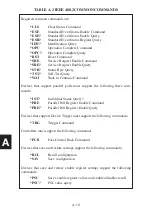
A-19
A2
of this standard (RS-232) has been in effect since 1969 and is known as
RS-232C. It specifies:
-
Mechanical characteristics of the interface
-
Electrical characteristics of the interface
-
A number of interchange circuits with descriptions of
their functions
-
The relationship of interchange circuits to standard inter-
face types
The specification does not mean that two devices that are RS-232 compatible
can be connected together with a standard cable and be expected to work.
Mechanically, RS-232 interfaces use a 25 pin male connector (DS-25P)
with the data terminals and a 25 pin female connector (DS-25S) with the
data communications units (modems).
Electrically, RS-232 signals are bipolar and are referenced to a common
ground (AB) on pin 7. Transmitted signals must be between
+
5 and
+
15V or
-5 and -15V into 3000 to 7000 ohm loads. Maximum open circuit transmit-
ter outputs is ±25V. Logic levels are:
+5 to +15V -5 to -15V
Data
0
1
Control
1 (On) 0 (Off)
Functionally, the specification established two types of devices, DCE and
DTE, that would mate together by a pin-to-pin cable. The Data Commu-
nication Equipment (DCE) was designated as the device that connected
to the communication line. An example of a DCE is a modem. The Data
Terminal Equipment (DTE) was designated as the device that connected
to the DCE. Examples of a DTE are a PC computer or a terminal. DTE
devices can be mated to DTE devices by a special 'null-modem' cable that
crosses the transmit signals of one device with the receive signals on the
other device.
Summary of Contents for 4809A
Page 5: ...ii This page left intentionally blank...
Page 51: ...2 30 2 This page left intentionally blank...
Page 89: ...4 8 4 This page intentionally left blank...
Page 99: ...5 10 5 This page left intentionally blank...
Page 125: ...A 26 A3 This page intentionally left blank...
Page 131: ...I Index 6 This page left intentionally blank...














































